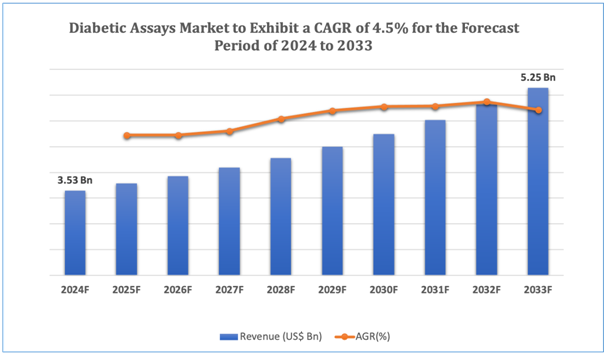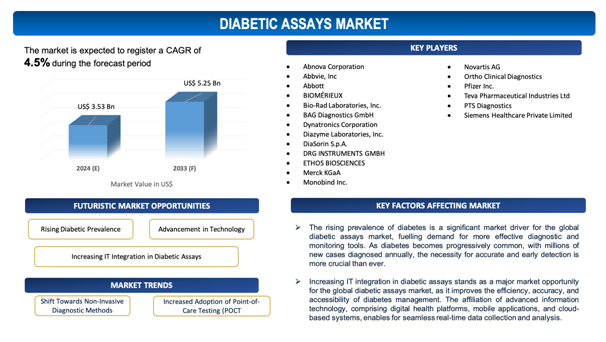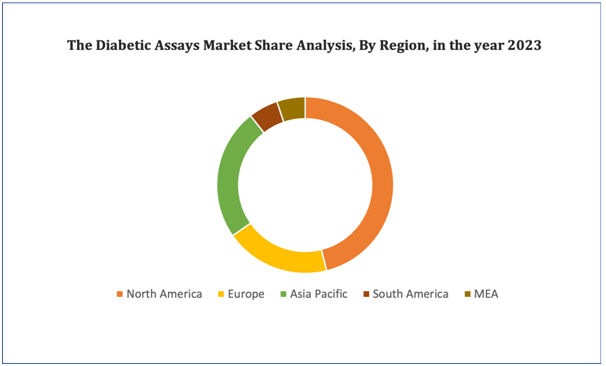Diabetic AssaysMarket Overview
The global Diabetic Assaysmarket is estimated to be worth over USD 5.25Bn in 2033 and is expected to grow at CAGR of 4.5% during the forecast period (2024-2033).
Diabetic assays are substantiallyrevolutionizing the pharmaceutical market by improving the precision and effectiveness of diabetes management. These diagnostic tools, which measure leading biomarkers such as glucose, haemoglobin A1c (HbA1c), and insulin levels, are crucial for monitoring and controlling diabetes. As the prevalence of diabetes continues to surgeworldwide, the demand for accurate and reliable assays is soaring. Diabetic assays allow early detection and diagnosis, which are essential in preventing the progression of diabetes and its complications. This early intervention approach is redefining the pharmaceutical outlook by shifting the focus towards personalized medicine, where treatment plans are customized to individual patient needs based on their specific biomarker profiles.
In addition to that, the confluence of advanced technologies, such as point-of-care testing and continuous glucose monitoring, is further advancing diabetic assays. These advancements are making assays more efficient, accessible, and user-friendly, resulting inenhanced patient compliance and better health outcomes. The ability to monitor glucose levels in real-time enables for dynamic adjustments to treatment regimens,enhancing the effectiveness of therapeutic interventions and minimizing the risk of adverse events.
The increasing significance of diabetic assays is also fuelling innovation within the pharmaceutical industry. Companies are investing heavily in research and development to create more accurate and cost-effective assays, as well as new drugs and therapies that work in conjunction with these diagnostic tools. This emphasis on precision medicine is leading to the development of more targeted treatments, which can improve glycaemic control and minimize the overall burden of diabetes.
In conclusion, diabetic assays are not only enhancing patient outcomes but also reshaping the competitive landscape of the pharmaceutical market, with greater focus on innovation, personalization, and the integration of cutting-edge technologies.
Figure 1. Diabetic Assays: Market Size

Get more details on this report - Request Free Sample
Key Market Insights
The global diabetic assays market is witnessingswift growth, fuelled by the increasing prevalence of diabetes across the world and the growing demand for precise, early diagnostic tools. Latest market insights reveal that progressions in assay technologies, such as the development of highly sensitive HbA1c tests and continuous glucose monitoring systems, are substantiallyimproving the efficiency and accuracy of diabetes management. The market is also experiencing the confluence of novel technologies like point-of-care (POC) testing, which enables for rapid, on-site diagnosis, and wearable sensors that provide continuous monitoring of glucose levels. These innovations are not only enhancing patient outcomes but are also making diabetes management more accessible and user-friendly, especially in remote and resource-limited settings.
Significant developments in the market comprise the adoption of digital health solutions, such as mobile health apps and cloud-based platforms, which allow real-time data sharing between patients and healthcare providers, supporting personalized treatment plans. In addition, there is a soaringemphasis on non-invasive glucose monitoring technologies, which aim to minimize the discomfort associated with conventional blood tests. The market panorama is marked by intense competition among leading players, with major investments in research and development to bring new, innovative products to market. Companies are also progressively collaborating with tech firms to integrate artificial intelligence (AI) and machine learning (ML) into diabetic assays, improving predictive analytics and allowing more proactive management of the disease. As these trends continue, the global diabetic assays market stands ready for continued growth, fuelled by technological developments and an escalated emphasis on personalized care
Market Dynamics
Market Drivers
Rising Prevalence of Diabetes
The rising prevalence of diabetes is a significant market driver for the global diabetic assays market, fuelling demand for more effective diagnostic and monitoring tools. As diabetes becomes progressively common, with millions of new cases diagnosed annually, the necessity for accurate and early detection is more crucial than ever. This rise in diabetes cases is largely driven by factors such as geriatric populations, urbanization, unhealthy diets, and sedentary lifestyles, which cooperatively contribute to the soaring incidence of both type 1 and type 2 diabetes.
In response to this rising health crisis, healthcare providers and governments are intensifying efforts to enhance diabetes management and prevention. Diabetic assays, which measure major biomarkers like glucose levels, haemoglobin A1c, and insulin, are critical for diagnosing diabetes, monitoring its progression, and tailoring treatment plans. As more individuals need regular monitoring to administer their condition effectively, the demand for reliable and advanced assays continues to surge.
Moreover, the soaring awareness of the significance of early detection in preventing complications, such as kidney failure, cardiovascular disease, and neuropathy, further boosts the need for diabetic assays. The market is also fuelled by the growing adoption of routine screening for high-risk populations, comprising thosewith a family history of diabetes or obesity. This trend not only highlights the critical role of diabetic assays in improving patient outcomes but also accelerates innovation and growth within the market, as companies strive to develop more precise, accessible, and user-friendly diagnostic tools to meet this augmenting demand.
Market Restraints
With regard to numerous advantages of diabetic assays, the market faces several challenges due to the unique characteristics and requirements associated with these potent pharmaceutical products. Some of the key market challenges include:
- High Cost of Advanced Diagnostic Tools: The global diabetic assays market witnesses a major restraint owing to the high cost related to advanced diagnostic tools and continuous glucose monitoring systems. These technologies, while highly effective, can be prohibitively expensive for many patients, especially in low- and middle-income countries. The cost of these assays deters their widespread adoption, especially in regions with constrained healthcare budgets, which in turn hinders market growth.
- Lack of Infrastructure and Accessibility in Developing Regions: In many developing regions, the lack of adequate healthcare infrastructure and limited accessibility to advanced diagnostic tools pose a major challenge to the growth of the diabetic assays market. Rural areas, notably, are likely to struggle with insufficient medical facilities, trained personnel, and reliable supply chains, making it arduous to implement and maintain diabetic assay technologies. This limitation curtails the market's expansion and the capability to fulfil the increasing demand for diabetes management solutions worldwide.

Get more details on this report - Request Free Sample
Market Opportunity
Increasing IT Integration in Diabetic Assays
Increasing IT integration in diabetic assays stands as a major market opportunity for the global diabetic assays market, as it improves the efficiency, accuracy, and accessibility of diabetes management. The affiliation of advanced information technology, comprising digital health platforms, mobile applications, and cloud-based systems, enables for seamless real-time data collection and analysis. This incorporationsupports more accurate monitoring of glucose levels, allowing personalized treatment plans customized to individual patient needs. The capability to continuously track and analyse patient data not only enhances disease management but also empowers patients to take a more active role in their health.
In addition, IT integration facilitates the development of advanced tools like artificial intelligence (AI) and machine learning (ML) algorithms, which can forecast trends in glucose levels and offer early warnings of potential complications. These predictive analytics can lead to proactive interventions, minimizing the risk of severe complications and improving patient outcomes. In addition, IT integration allowsimproved communication and data sharing between patients and healthcare providers, enabling for more coordinated and effective care.
The adoption of telemedicine and remote monitoring systems, fuelled by IT integration, also expands the reach of diabetic assays, making them accessible to patients in remote or underserved areas. This expansion is critical in addressing the global diabetes epidemic, particularly in regions where conventional healthcare infrastructure may be lacking. As IT integration continues to advance, it opens up new avenues for growth and innovation in the diabetic assays market, making it a major driver of future market expansion.
Market Trends
- Shift Towards Non-Invasive Diagnostic Methods: A significant trend in the global diabetic assays market is the increasing shift towards non-invasive diagnostic methods. Conventional blood-based assays are progressively being supplemented or replaced by technologies that offer glucose monitoring through skin patches, breath analysis, or optical sensors. These non-invasive methods are gaining popularity owing to their ease of use, minimized discomfort, and potential to enhance patient compliance. As research and development continue to advance these technologies, they are estimated to capture a bigger share of the market.
- Increased Adoption of Point-of-Care Testing (POCT): Another significant trend is the increasing adoption of point-of-care testing (POCT) in diabetic assays. POCT allows for rapid, on-site testing, offering immediate results that enable timely decision-making and treatment adjustments. This trend is particularly strong in outpatient settings, primary care, and remote areas where quick diagnostics are critical. The speed, convenience, and accuracy of POCT are fuelling its popularity, and as these technologies become more affordableand advanced, their use is estimated to grow, further amplifying the diabetic assays market.
Diabetic Assays Market: Key Segments
By Method
- ELISA
- Point of Care Testing
- Enzymatic Assay
- Colorimetric Assay
- Others
By Product Type
- Instruments
- Testing Kits
- Reagent
By Disease Type
- Type 1 Diabetes
- Type 2 Diabetes
- Gestational Diabetes
By End-Users
- Hospitals
- Homecare
- Specialty Clinics
- Others
By Distribution Channel
- Hospital Pharmacy
- Online Pharmacy
- Retail Pharmacy
By Key Geographical Regions
- North America
- Europe
- Asia-Pacific
- Middle East and Africa
- South America
Figure 4. Diabetic Assays Market: Distribution by Region

Get more details on this report - Request Free Sample
Diabetic Assays Market: Regional Analysis
North America is expected to show significant growth in the diabetic assays market due to increasing diabetes prevalence in the U.S. This necessitates higher demand for assays to detect and identify diabetes cases, driving market expansion throughout the forecasted period.
Asia-Pacific is expected to dominate the diabetic assays market due to its emerging economic conditions and increased vendor investments. These factors facilitate widespread development of diabetes assays, catering to the region's growing healthcare demands and technological advancements. The region's proactive approach positions it as a pivotal player in advancing diabetes diagnostics and management solutions globally.
Leading Diabetic Assays Developers
Industry Trends and Global Forecasts, 2023-2035 report features an extensive study of the current market landscape, market size and future opportunities associated with the Diabetic Assaysmarket, during the given forecast period. Further, the market report highlights the efforts of several stakeholders engaged in this rapidly emerging segment of the biopharmaceutical industry. Key takeaways of the diabetic assaysmarket are briefly discussed below.
The report includes the list of players operating in the global diabetic assays market. Some of the key players include:
- Abnova Corporation
- Abbvie, Inc
- Abbott
- BIOMÉRIEUX
- Bio-Rad Laboratories, Inc.
- BAG Diagnostics GmbH
- Dynatronics Corporation
- Diazyme Laboratories, Inc.
- DiaSorin S.p.A.
- DRG INSTRUMENTS GMBH
- ETHOS BIOSCIENCES
- Merck KGaA
- Monobind Inc.
- Novartis AG
- Ortho Clinical Diagnostics
- Pfizer Inc.
- Teva Pharmaceutical Industries Ltd
- PTS Diagnostics
- Siemens Healthcare Private Limited
Diabetic Assays Market: Key Developments
- In March 2024,a new test by Randox, developed with JDRF-funded researchers at the University of Exeter, is the first in the world to use genetics to quickly identify who is at high risk of developing type 1 diabetes.
Scope of the Report
The market report presents an in-depth analysis of the various firms / organizations that are engaged in this market, across different segments, as defined in the below table:
|
|
Key Report Attributes |
Details |
|
|
Base Year |
2023 |
|
|
Forecast Period |
2024-2033 |
|
|
CAGR (2024-2033) |
4.5% |
|
|
Method |
|
|
|
Product Type |
|
|
|
Disease Type |
|
|
|
End Users |
|
|
|
Distribution Channel |
|
|
|
Key Geographical Regions |
|
|
Key Companies Profiled |
|
|
